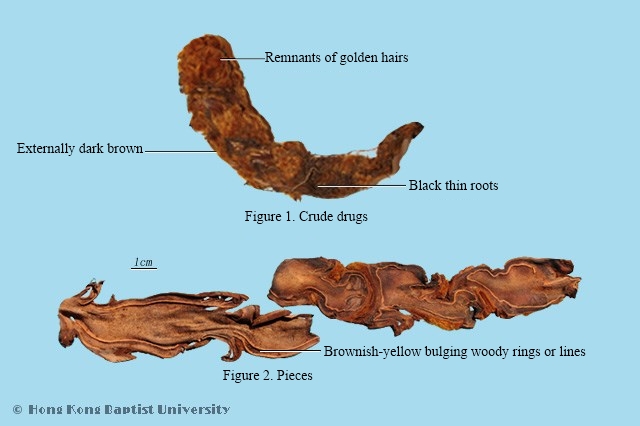Production RegionsPrimarily produced in the Chinese provinces of Sichuan, Fujian.
Macroscopic FeaturesIrregular long lumps, 10~30cm long, 2~10cm diameter. Externally dark brown, remnants of golden hairs; upper side has numerous reddish-brown woody petioles, lower side has remnants of black thin roots. Firm texture, difficult to break. faint odor, tasteless and slightly astringent taste. Unprocessed gou ji is in irregular long lumps or round pieces, 5~20cm long, 2~10cm diameter, 1.5~5mm thick; fractured surface is pale brown, relatively smooth; one brownish-yellow raised xylem ring or strip is present at approximately 1~4mm of edge; edge is not smooth, sometimes has remnants of golden hair. Brittle texture, easily broken and powdery. Processed gou ji is black-brown, hard texture, xylem has obvious rings.
Quality RequirementsSuperior medicinal material has firm texture, heavy and golden hair.
PropertiesBitter, sweet; warm.
FunctionsDispels wind and dampness, supplements the liver and kidney, strengthens waist and knees. Apply to win and damp impediment, weakness in the loins and knees, weakness of the lower limbs, frequent urination, enuresis, leukorrhagia; externally used to trauma and bleeding.
Processed FormSteamed gou ji: Steam clean gou ji slices with fast fire for 4~6h in the steamer, covered for 6~8h after ceased fire, take out and dry. Reduced the nature of bitter and dry, advanced in supplement the liver and kidney. Wine gou ji: stir the clean gou ji slices with yellow rice wine, steam after wet the gou ji slices, with fast fire, for 4~6h, covered for 6~8h after ceased fire, take out and dry. Every 100kg gou ji slices need 15kg yellow rice wine. Wine gou ji is advanced in disperse cold and stop pain, promotes joints. Salt gou ji: stir the clean gou ji slices evenly with salt water, wet it for about 3h, after absorb completely, steam for 3h, take out and dry. Salt gou ji is advanced in supplement liver and kidney and strengthen the waist and knees.
OriginThe dried rhizome of Cibotium barometz (L.) J. Sm. (Dichsoniaceae)
